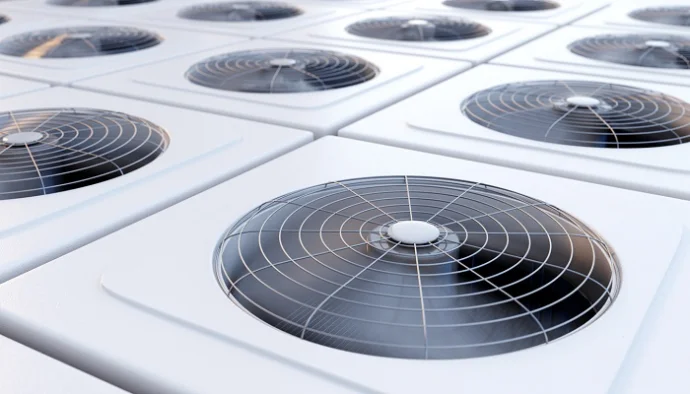Why Airflow Management is a Hot Topic for Data Centre Racks
Data centres and server rooms should be designed around the workload they have to support both from day-one and in the future. This is not always the case and many server room operations evolve from their initial concept, driven by changes in demands, workloads and technology. This can lead to inefficiencies and less than optimum design in terms of critical systems and resilience.
One of the least obvious changes to layouts is driven by the different air flow demands that the latest technologies supporting the digital economy require. High power computing (HPC) being one such instance with a higher power density and cooling requirement than a more traditional rack of servers. Outside a data centre, the more ‘traditional’ server is also becoming more powerful and as power increases so does the heat output and need for more intelligent cooling controls.
Server Rack Air Flow Management
Air flow management in a data centre environment can dramatically impact energy efficiency and operational resilience. The topic is a science itself and one that requires a sound engineering approach and study both at the design stage and when changes to the server rack layouts are being planned.
Small server rooms will often take a very simple and straightforward approach to cooling and the maintenance of temperature and humidity. The room may only house one or a small number of server racks and use a split air conditioning system to cool the environment. The site may or may not deploy temperature and humidity monitoring, either through a dedicated monitoring system or as part of the accessories available for their power distribution units (PDUs).
The decision as to how to monitor temperature and humidity in a server room is an important one. This size of computer room tends to be unmanned and not inspected regularly. The air conditioner may be remotely monitored to pick up an alarm condition or it may not. Failure of the air conditioning system can lead to a rapid heat build up within the room and the potential for overheating within a rack and the risk of a fire within a server rack. Intelligent power distribution units can often be installed with multiple sensors allowing the rack to provide a gateway for temperature and humidity monitoring a set points within the server rack. The only alternative to this is to put in place a dedicated temperature and humidity monitoring system. The advantage of this is that the system can still be network monitored, providing alerts via email and SMS and may also have the facility to monitor other sensors including water, smoke and security access related events.
In a larger data centre environment the room layout and amount of heat to be managed will often lead to the demand for a more strategic approach. An entire cooling system will be developed for the room based more on its specific characteristics and the workload demands on its servers. Cooling systems can vary from chilled air to liquid-based cooling systems using room installed air conditioners or hot or cold-aisle containment. The load profile may also lead to a combination of cooling systems if there is a mixture of server loads from the more generic to those for HPC environments running artificial intelligence (AI) and machine learning applications.
What links the two ends of the server environment spectrum (simple server room to HPC data centre) is of course air low management. Not just the temperature and humidity but also the movement and control of both cool air flows and hot air exhaust channels. In a small server room, cooling air flow can often be easily managed. Hotspots can be avoided within server racks by re-configuration of the IT layouts and the use of blanking plates and well fitted side panels to ensure efficient from to read cabinet air flow. Within the more complex HPC environment thermodynamic modelling may be required with complex calculations and possible bespoke engineering solutions to solve air flow and cooling issues.
High end data centre technologies and practices often migrate over time to smaller server room environments. Hyperscale data centres continue to lead the way through their deployment of data centre infrastructure management (DCIM), data analytics, bid data tools, artificial intelligence and machine learning. Over time these will be distilled into technologies that could be deployed at the server room level.
Dynamic Cooling Systems
Dynamic cooling systems is one such approach that could impact smaller applications. A dynamic system automatically matches the performance of the cooling system to the heat demands of the load profile. This type of cooling approach is more energy and cooling efficient as it only uses the cooling capacity required at any given time. Cooling units can be left in idle or sleep mode when not in use and become loaded only when there are enough changes in temperature or humidity to warrant this. Airflow into HPC type server racks is automatically adjusted to requirements and the system is monitored via the DCIM system. Whilst designed for data centres with raised access floors, the cooling solution may also be practical within those environments without a raised access floor.
Summary
The digital economy continues to drive the need to develop ever more powerful servers who cooling, and air flow demands increase proportionally. Within a confined space like a server room or data centre it is vital to ensure that the right cooling technology is deployed and that it is working as efficiently as possible whilst also being adaptable to future workload changes. Where this cannot be automatic as a dynamic response, the initial design will need to be reassessed each time a change is introduced to ensure the resilience of the entire facility is not compromised.
It is also always worth remembering that a server rack is not just a housing but a channel for air flow. For many server room racks the greatest improvements in cooling efficiency can come from the use of blanking plates and well fitted floor tiles, in a data centre environment the same principles apply in addition to preventing the cold and hot airflows from mixing.
For more information on the topic of data centre rack air flow management practices visit: https://journal.uptimeinstitute.com/implementing-data-center-cooling-best-practices/.

























